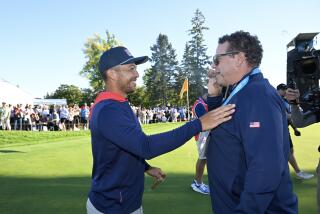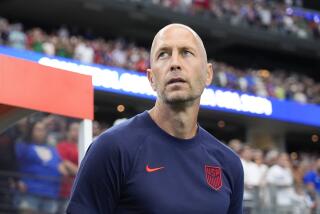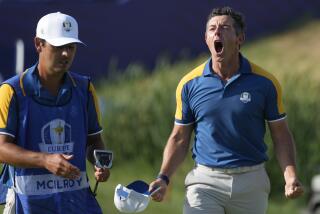Turning Point
- Share via
SOTOGRANDE, Spain — What’s automatic? A car’s transmission. A fourth-down punt when you’re deep in your own territory. Politics as usual. Fireworks on the Fourth of July. Azaleas at the Masters. Rough at the U.S. Open. Tiger Woods making a commercial.
Let’s see, guess that about covers it. Granted, it’s not that long a list, but it once was. It was longer when you could be absolutely sure that something else would happen, something as automatic as a garage-door opener.
The U.S. would win the Ryder Cup.
It was the same every time. American golfers would show up anywhere from Surrey to St. Louis, administer a sound thrashing to their golfing counterparts from Great Britain--and by 1979 all of Europe--then wait two whole years and thrash them again.
It was all so straightforward, so uncluttered. But it was also a simpler time. Here were the unwritten rules: If you were an American, you dropped your bag at the clubhouse, selected the proper instrument of torture, had dinner, wore a snappy blazer and then threw Sam Ryder’s old cup back in the suitcase for another couple of years.
It was automatic, all right, but it was also sort of pathetic. From 1935 through 1983, U.S. players beat the best golfers from Britain and Europe like a rug, winning 20 of 21 matches.
Sometimes, they deserved it, of course, like in 1973. That’s when Great Britain-Ireland wore light-colored jackets with dark piping around the lapels that made the team look like ice cream salesmen, or a vaudeville act.
But in 1985, something unusual happened at the Belfry in Sutton Coldfield, England. Now, for anyone who thought that it would be a cold day in Coldfield before Europe ever won the Ryder Cup, well, we give you Sept. 13-15, 1985, when that’s exactly what happened.
Europe’s golfers trounced the U.S., 16 1/2-11 1/2 and won the Cup for the first time since 1957. It was a momentous victory, not only because the U.S. lost, but because it probably saved the Ryder Cup from being relegated to some sort of useless existence as a prop in a forgotten series of one-sided blowouts.
Europe won again in 1987, retained the Cup with a tie in 1989 and won it back in 1995 after U.S. victories in 1991 and ’93. If that’s not parity . . . well, the only thing automatic about the Ryder Cup is that there’s nothing automatic about it any longer.
In fact, the visiting team has won the last two Ryder Cups. Stick that in your cavity-backed, graphite-shafted iron.
The Belfry’s Brabazon course, with its manicured fairways and man-made lakes, seemed made to order for a U.S. team that featured Ray Floyd, Lanny Wadkins, Tom Kite, Curtis Strange, Fuzzy Zoeller, Craig Stadler, Peter Jacobsen and Mark O’Meara.
Zoeller conceded the final putt to Jose Maria Canizares of Spain to end it, which set off a wild celebration by 25,000 fans who showed up in chilly weather to see something really hot. Sam Torrance and captain Tony Jacklin climbed on the roof of the pro shop and sprayed the crowd with champagne.
Lee Trevino, the U.S. captain, could only watch.
“We lost, and I love to win,” Trevino said. “But I learned a long time ago that anybody can smile when they win. It takes a hell of a man to smile when you lose. It was no disgrace. We lost to a good, strong, team.”
The U.S. team, which took a 3-1 lead in the morning foursomes on the first day, got run over from then on.
Canizares and Jose Rivero, a Spanish club pro, routed Kite and Calvin Peete, 7 and 5, in Saturday afternoon’s foursomes. Seve Ballesteros and Manuel Pinero routed Stadler and Hal Sutton, 5 and 4, in the next match.
Howard Clark sank a 55-foot putt to help him and Torrance defeat Kite and U.S. Open champion Andy North.
Woosnam and Paul Way combined for eight birdies to defeat Zoeller and Hubert Green. Pinero made three birdies on the back nine to beat Wadkins, 3 and 1, with the U.S. trailing by two in the first singles match.
In Friday’s afternoon matches, Stadler missed a two-footer on the last hole, allowing Europe to halve that match. After Friday, the U.S. would not hold the lead alone again. As far as turning points went, this was a giant one, according to Jacklin.
“In the past, it was always us who missed those putts,” he said. “That had to crush them.”
Until 1985, the U.S. held a 21-3-1 lead in the Ryder Cup series. It’s now 23-6-2, but at least it’s a race.
Naturally, Jacklin was ecstatic.
“Unbelievable,” he said. “It’s history. We made history.”
And as it turned out, they also made the Ryder Cup.
More to Read
Go beyond the scoreboard
Get the latest on L.A.'s teams in the daily Sports Report newsletter.
You may occasionally receive promotional content from the Los Angeles Times.










